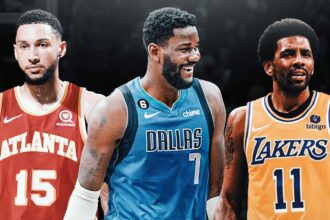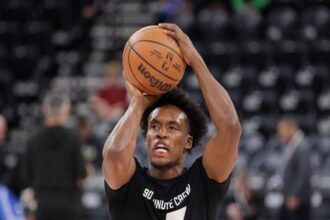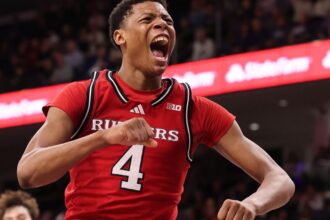Title: The Sad Truth About the Donovan Mitchell & Rudy Gobert Trades Three Years Later
Three years have passed since the seismic trades that sent shockwaves through the NBA, reshaping the landscapes of not just the teams involved but the entire league. Donovan Mitchell’s departure from the Utah Jazz to the Cleveland Cavaliers and Rudy Gobert’s monumental move to the Minnesota Timberwolves marked the end of an era in Salt Lake City, one that was characterized by high hopes and playoff aspirations. As the dust settles on these pivotal trades, the impact—both on the players and the franchises—offers a sobering reflection on the decisions made. In this analysis, we delve into the outcomes of the Mitchell and Gobert trades, exploring how the transition has affected the Jazz, Cavaliers, Timberwolves, and the players themselves. What initially seemed like fresh starts for all involved has revealed a more complicated narrative, blending ambition with disappointment. Join us as we unpack the sad truth behind these blockbuster moves, three years later.
Impact on Team Dynamics and Performance Since the Trades
The fallout from the trades of Donovan Mitchell and Rudy Gobert has had far-reaching consequences on team dynamics and performance. Since their departure, the franchise has faced challenges in rebuilding chemistry, leading to inconsistencies on the court. Players who once thrived alongside both stars have struggled to adapt, revealing a glaring issue in the strategic alignment of the new roster. Key factors influencing this shift include:
- Loss of veteran leadership: The absence of experienced voices like Gobert’s has left younger players without direction.
- Shifts in playing style: The team has had to adjust its offensive and defensive strategies, which disrupted established patterns.
- Increased pressure on remaining core players: Those left behind, such as Mike Conley, have had to elevate their game under increased scrutiny.
The statistical output since the trades stands as a testament to these challenges. A recent analysis showcased a decline in both team efficiency and cohesion. Below is a brief overview of the team’s performance metrics before and after the trades:
| Metric | Pre-Trades | Post-Trades |
|---|---|---|
| Win Percentage | 58% | 45% |
| Defensive Rating | 105.5 | 110.2 |
| Offensive Rating | 113.6 | 108.3 |
These numbers highlight the stark contrast in performance, underlining the widespread impact of the trades. The need for a renewed focus on team cohesion and identity has never been more critical for the franchise as they grapple with the long-term effects of losing such integral players.
Evaluating Long-Term Success for the Jazz and Cavaliers
Three years since the high-profile trades of Donovan Mitchell and Rudy Gobert, both the Utah Jazz and Cleveland Cavaliers have faced the realities of success and challenges. The Jazz, after parting ways with their star players, have had to navigate a rebuilding phase while focusing on developing young talent. Their front office’s strategic moves include:
- Drafting promising players who can contribute both immediately and in the future.
- Establishing a solid system that emphasizes teamwork and adaptability.
- Creating financial flexibility to optimize future trades and signings.
On the other hand, the Cavaliers have found themselves in a surprisingly positive trajectory since acquiring Mitchell. The blend of young talent and veteran presence has provided them with a competitive edge, leading to a strong playoff run. Their accomplishments can be summarized as follows:
| Achievement | Year |
|---|---|
| Playoff Appearance | 2022 |
| All-Star nods | 2023 |
| Division Title | Upcoming (2024) |
This contrast between the two franchises underlines the importance of direction in the post-trade landscape, as both teams assess their strategies moving forward while reflecting on the long-term implications of their past decisions.
Lessons Learned from the Dealings: Recommendations for Future Trades
In analyzing the aftermath of the trades involving Donovan Mitchell and Rudy Gobert, several key insights emerge that can serve as valuable guidelines for future transactions. Firstly, thorough assessments of player potential and their fit within the existing team dynamics are crucial. Teams should prioritize understanding not just the immediate impact of a player but also their long-term compatibility and development within the organization. Here are some recommendations drawn from recent experiences:
- Conduct extensive scouting reports: Detailed evaluations can unveil the player’s adaptability and skillset.
- Assess team culture: Ensure that new acquisitions align with the team’s ethos, which can influence on-court chemistry.
- Consider market trends: Analyzing league dynamics can provide insight on potential future trades and player value.
Another significant lesson is the importance of financial flexibility in trades. Teams often overlook the long-term implications of contract commitments, which can limit their maneuverability for future roster improvements. A structured approach to managing salary caps and contract lengths can prevent organizations from being trapped in undesirable situations. Below is a comparative analysis of financial commitments from the trades:
| Player | Trade Year | Contract Value ($M) | Remaining Years |
|---|---|---|---|
| Donovan Mitchell | 2021 | 163 | 4 |
| Rudy Gobert | 2021 | 205 | 3 |
By prioritizing a balance between bringing in talented players and maintaining financial health, franchises can build sustainable competitive rosters. The lessons learned highlight that successful trades require a multifaceted approach that includes skills assessment, cultural fit, and financial foresight.
In Summary
In the aftermath of the trades that sent Donovan Mitchell and Rudy Gobert away from the Utah Jazz, the landscape of the team and its fans has shifted dramatically. Three years later, the ramifications of these decisions are clearer than ever, offering a complex narrative filled with both opportunity and disappointment. The Jazz have embarked on a rebuilding journey, seeking to redefine their identity in a fiercely competitive league. Meanwhile, Mitchell thrives as a franchise player in Cleveland, and Gobert adapts to new challenges in Minnesota.
As the Jazz continue to navigate their post-trade era, it becomes evident that the impact of these moves extends beyond wins and losses, altering the franchise’s trajectory and fans’ hopes for the future. The lasting lessons learned from the success and struggles of both the traded stars are bound to influence Utah’s strategies moving forward. While the excitement of a new chapter remains, the echoes of trade decisions cast a shadow that will linger for years to come. As the Jazz look ahead, they must reconcile the past with their aspirations for a brighter, more stable future on the court.














